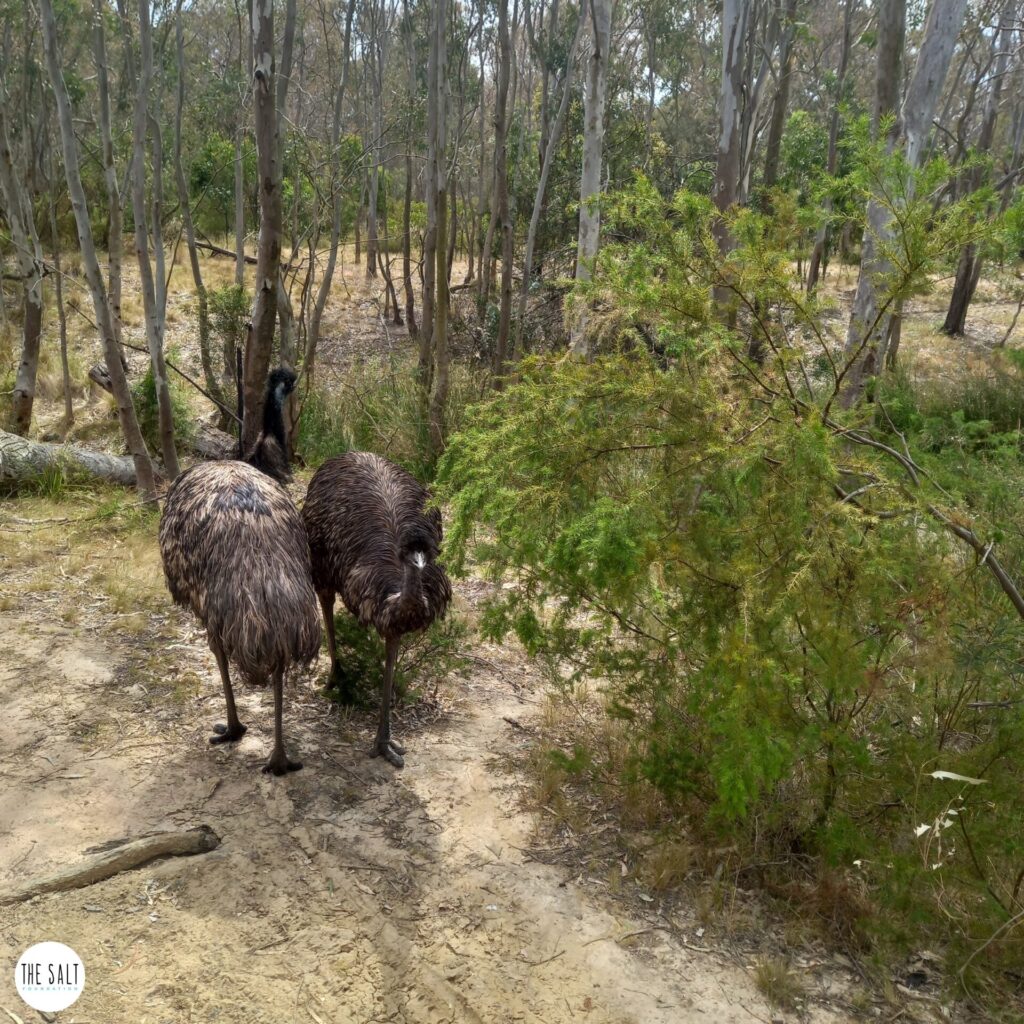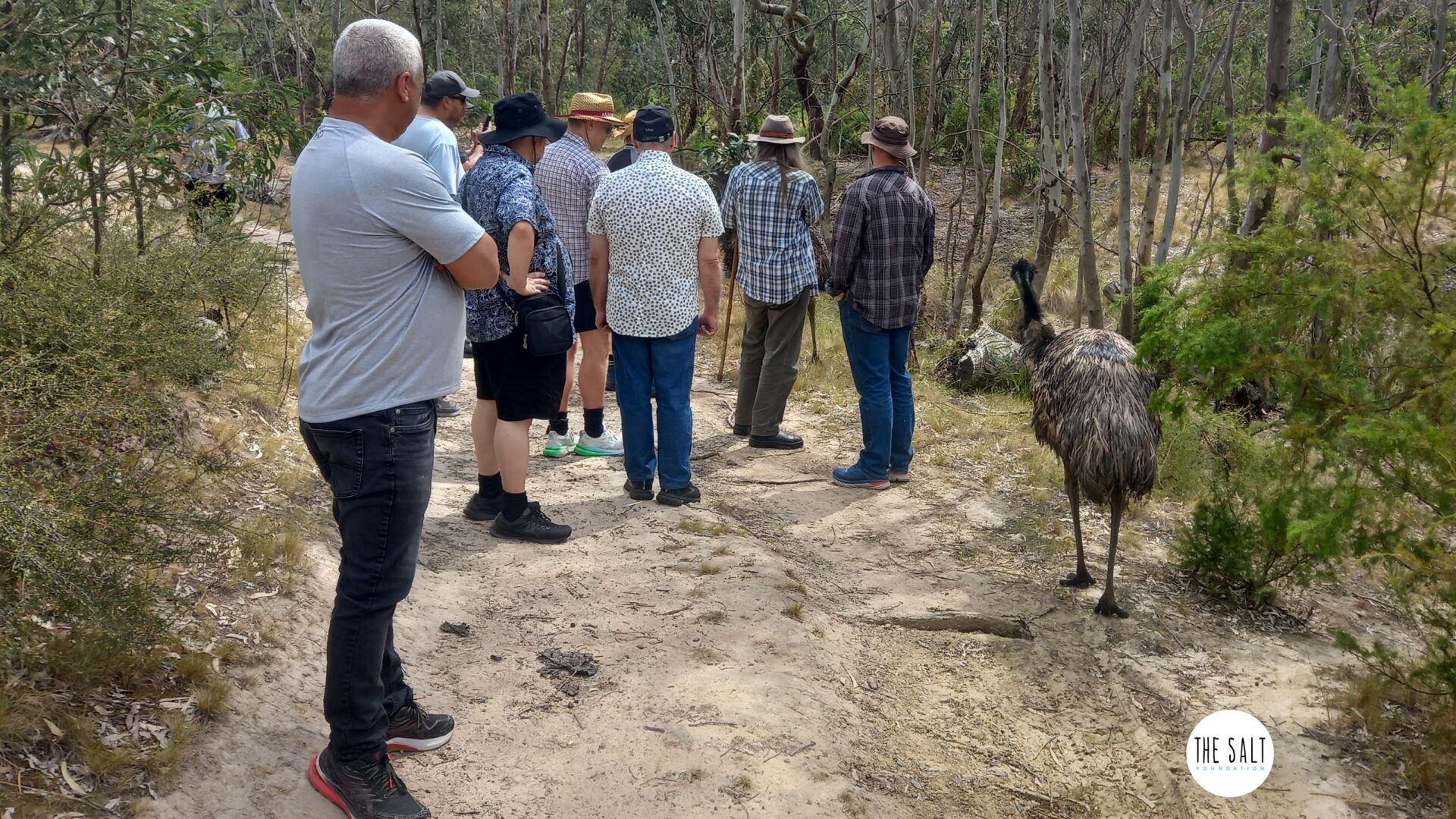Estimated reading time: 7 minutes
Have you ever noticed how much better you feel after spending time in nature? That refreshed, calmer feeling isn’t just in your head — it’s called eco therapy. As someone who’s battled bipolar disorder for decades, I’ve found that connecting with nature is one of my most effective coping strategies. Here in Victoria, we’re blessed with incredible natural spaces that offer powerful tools for mental health support.
Table of Contents
Key Takeaways
- Eco therapy uses nature-based activities to improve mental and physical health
- Research shows spending just 3-4 minutes in nature can reduce stress hormones and lower blood pressure
- The SALT Foundation partners with La Trobe University Wildlife Sanctuary for guided eco therapy sessions
- Eco therapy activities create natural opportunities for social connection without pressure
- People with disabilities can experience significant mental health benefits from regular nature exposure
What Is Eco Therapy and Why Does It Matter?
Eco therapy is a psychological approach that recognises the healing power of nature. It’s based on the simple truth that humans evolved in natural environments, not concrete jungles.
“Eco therapy is rooted in the theory that your health is directly affected by your surroundings,” explains Ben Rinaudo, a disability support worker at The SALT Foundation. “It uses physical interaction with nature as a tool for healing.”
This isn’t just a feel-good philosophy. Hard science backs it up. Studies show that within just 3-4 minutes of viewing nature scenes, blood pressure drops, stress hormones decrease, and mood improves. One study found that 95% of people reported mood improvements after spending time outdoors.
For people with disabilities, who may face unique barriers to wellbeing, nature provides an accessible path to better mental health.
The SALT Foundation’s Eco Therapy Success Stories

The SALT Foundation recently received a $5,000 grant from the Green and North East Community Grants program. This funding supports our partnership with La Trobe University Wildlife Sanctuary.
“We kicked off eco therapy activities with a guided educational tour of the La Trobe University Wildlife Sanctuary,” says Rinaudo. “We had about 10 people come along to that, and that was fantastic.”
Upcoming activities include a twilight tour with head torches to spot nocturnal animals. Participants will also enjoy nest box making workshops, native plant propagation, and tree planting sessions.
“People have stepped out of their comfort zones and found that they enjoy these activities,” Rinaudo adds. “They get to meet people in a way that’s not as confronting because we’re doing outdoor excursions.”
9 Types of Eco Therapy Anyone Can Try
Let’s explore different eco therapy approaches that work well for people with varying abilities and preferences.
1. Wilderness Therapy
This foundational approach immerses you completely in natural settings. In Victoria, this might mean spending time in the Dandenong Ranges or along the Great Ocean Road.
The theory behind wilderness therapy is simple. Your surroundings directly impact your health. By changing your environment, you can change your mental state.
2. Informal Trash Pickup
This eco therapy approach combines environmental stewardship with physical activity. Grab some gloves and a bag, then head to your local park or beach.
You’ll get fresh air, exercise, and the satisfaction of making a difference. This activity works beautifully for groups, creating natural conversations without social pressure.
3. Green Exercise
Any outdoor physical activity counts as green exercise. This could be hiking, swimming, or simply walking through a local park.
In Melbourne, the Royal Botanic Gardens offers accessible paths for walks. The Yarra Trail provides lovely routes for cycling or strolling. Even a gentle frisbee toss at your neighbourhood park qualifies.
4. Forest Bathing or Forest Therapy
This Japanese practice (shinrin-yoku) involves mindfully experiencing a forest through all your senses. No actual bathing required!
Victoria’s Dandenong Ranges and Sherbrooke Forest offer perfect settings for forest bathing. The practice reduces cortisol levels and boosts immune function, according to research from Dr. Qing Li of Nippon Medical School.
5. Nature Arts and Crafts
Creating art with natural materials connects creativity with nature appreciation. Collect leaves, twigs, or stones to make collages, sculptures, or decorations.
This activity works well for people with limited mobility. A caregiver can gather materials and bring them to a comfortable outdoor setting or even indoors.
6. Taking Regular Activities Outside
Simply moving your regular activities outdoors counts as eco therapy. Read a book in the park. Enjoy a coffee on a garden bench. Have your therapy session during a gentle walk.
“You can just wander at your pace and admire the beauty and interact with others as much or as little as you want,” says Rinaudo. “There isn’t pressure that you have to talk the whole time.”
7. Gardening
Gardening connects you directly with soil, plants, and the cycles of nature. Whether you have a backyard garden or a single pot on a windowsill, growing plants offers therapeutic benefits.
Community gardens in Melbourne offer plots for those without garden space. The activity provides gentle exercise, fresh produce, and often, new friendships.
8. Camping
Spending a night under the stars creates a deep nature connection. Victoria offers many accessible camping options, from primitive sites to glamping experiences.
Even backyard camping counts! The simple act of sleeping outside shifts perspective and resets your internal clock.
9. Animal-Assisted Therapy
Connecting with animals in natural settings combines two powerful therapeutic elements. Victoria’s wildlife sanctuaries offer opportunities to observe and sometimes interact with native animals.
“We recently partnered with AROCHA, a Christian environmental organisation,” Rinaudo shares. “They kindly took us out on a free tour of the Historic Woodlands Park for bushwalking and bird watching.”
The Mental Health Magic of Eco Therapy
The benefits of eco therapy extend far beyond simple relaxation. For people with mental health challenges, nature connection offers measurable improvements.
“All the feedback I’ve had from people is that the walks have been good,” says Rinaudo. “They’ve enjoyed getting out and about, out of the house, in a different environment.”
This aligns perfectly with research. Studies show eco therapy helps reduce symptoms of depression and anxiety, improves mood, enhances self-esteem, and creates a sense of belonging.
For those experiencing isolation—a common challenge for people with disabilities—eco therapy provides natural social opportunities. As Rinaudo explains, “What we’re doing at SALT, in addition to the benefits of being out in nature, is trying to build community and a sense of belonging.”
Conclusion
Eco therapy offers a powerful approach to improving mental health through nature connection. The research is clear: spending time in natural settings provides real, measurable benefits for your mind and body. You don’t need special equipment or training to start—just a willingness to step outside.
Whether you’re managing depression, anxiety, or simply want to feel better, nature is waiting to help. The most successful eco therapy practice is the one you’ll actually do regularly. Find what brings you joy in nature and make it part of your routine. Your mind and body will thank you.
Action Steps
- Start simple: Spend 15 minutes daily in your backyard, local park, or any green space
- Join one of The SALT Foundation’s eco therapy activities (contact us for the schedule)
- Try a different type of eco therapy each week until you find what resonates with you
- Bring nature indoors with houseplants, natural materials, or nature sounds
- Partner with a friend or support worker to make outdoor activities more accessible
Frequently Asked Questions (FAQs)
Yes. Multiple scientific studies confirm the mental health benefits of nature exposure. Research shows that spending time in nature reduces stress hormones, lowers blood pressure, improves mood, and enhances immune function. Even brief nature exposure (3-4 minutes) produces measurable improvements.
Absolutely. Eco therapy can be adapted for all ability levels. Options include sensory gardens, indoor plants, nature craft, window bird feeders, or simply sitting in a park. The SALT Foundation can help design eco therapy activities tailored to your specific needs and abilities.
Studies show benefits from even brief nature exposures. Most experts recommend at least 20-30 minutes in nature three times weekly for optimal effects. However, any amount is beneficial. Even looking at nature photos or having plants in your home provides some benefits.
No. Eco therapy works best as a complement to traditional treatments like medication and talk therapy. Always consult your healthcare provider before changing your treatment plan. Many mental health professionals now recognise eco-therapy as a valuable addition to comprehensive care.
The SALT Foundation offers regular eco therapy activities in Melbourne. You can also check with local community centres, botanical gardens, and parks for nature walks and outdoor activities. Many NDIS providers now incorporate eco therapy elements into their programming.
Daniel G. Taylor has been writing about the NDIS for three years. His focus has been on mental health and psychosocial disabilities as he lives with bipolar disorder I. He’s been a freelance writer for 30 years and lives across the road from the beach in Adelaide. He’s the author of How to Master Bipolar Disorder for Life and a contributor to Mastering Bipolar Disorder (Allen & Unwin) and he’s a mental health speaker.

